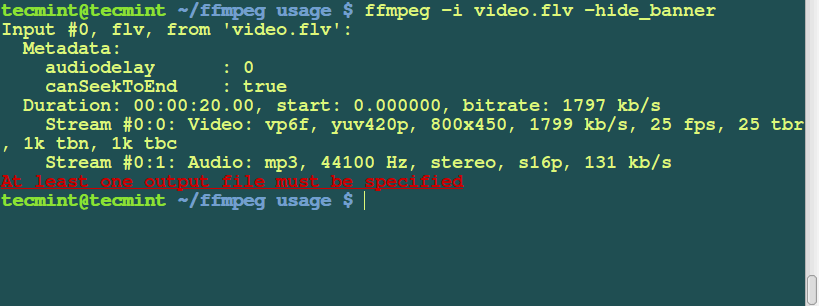

- #FFMPEG CONVERT FRAME RATE AND SPEED MP4#
- #FFMPEG CONVERT FRAME RATE AND SPEED DOWNLOAD#
- #FFMPEG CONVERT FRAME RATE AND SPEED MAC#
$ ffmpeg -ss 61.0 -t 2.5 -i StickAround.mp4 -f gif StickAround.gifīut I wouldn’t recommend it. Seeing the simplicity of the above examples, you might be tempted to create a gif with FFmpeg like so: Note that these methods don’t play nicely with sources with transparency/alpha *yet* – hopefully more on that in a future blog post. Here’s a handy guide for encoding H.264 video should you be interested in the ins and outs of that particular format. That about does it for GIFs to video formats. This should keep your weird gif timing intact. This vsync flag tells ffmpeg to not modify the timing of the frames as they come from the decoder. If you don’t want to lose any visual content, I suggest you set the value to the nominal framerate of the input, so the inverse of the minimum frame delay.

This is the fps or “frames per second” or “framerate” filter. If you had a file with multiple video streams, or you put two inputs in the command you could imagine selecting the second video stream with, or the third audio stream as, etc, etc. This specifies that we will be using the first video stream fed to FFmpeg as input to this section of the filter. This is a very simple example of a filter, but if you read on you can see things get a bit more complex. Filters process raw video or audio based on the name of the filter and the arguments specified. This here is how you specify a filter graph. Some of the above arguments look pretty familiar, right? Let’s go over what’s changed. If your particular application might be sensitive to such issues, you can try the following command:
#FFMPEG CONVERT FRAME RATE AND SPEED MAC#
If I were to use the previous command to convert my contrived and not very useful as a countdown example, 321.gif, the VLC player on my Mac has trouble playing that mp4.

While the above generally works with most content, you may be interested to learn that GIFs support widely varying frame rates or frame delays that when converted to a video format without transformation, can trip up certain video players. If you think you know better and are immune to pain and regret then you can add the -y flag somewhere in your command and it will automatically overwrite the file if it exists. It’ll create the file if it doesn’t exist and if it already exists, you will be prompted on the command line to confirm if you’d like to overwrite the existing file. This is another optional flag, but I use it because it makes the file play nicely in the QuickTime Player, and subsequently Finder, on my Mac. FFmpeg will typically infer that from the extension supplied in the output file pattern, but when it comes to working with FFmpeg it doesn’t hurt to be specific.
#FFMPEG CONVERT FRAME RATE AND SPEED MP4#
This tells FFmpeg that we want to output to an mp4 media container. I’m also assuming that benji.gif is a gif of my stubbornly smelly pug and that it is in your shell’s current working directory. I’m assuming here that your shell knows the complete path to it. Let’s break down this command and its constituent arguments. $ ffmpeg -i benji.gif -f mp4 -pix_fmt yuv420p benji.mp4 Say you have a gif of my ancient, computer illiterate pug, Benji, and you want to convert it to a video format. The easiest way to do that is to go here and find a static build for whatever platform you’re working on. To follow along you’ll need FFmpeg installed. In that light, I wrote this post to share and explain some of its functionality, especially as it relates to GIF transcoding. Maybe you can read the documentation and make some sense of it, or maybe you feel the same way about reading words as me. It’s packed with an enormous amount of functionality. It supports the most obscure ancient formats up to the cutting edge.” “FFmpeg is the leading multimedia framework, able to decode, encode, transcode, mux, demux, stream, filter and play pretty much anything that humans and machines have created. For those of you who are unfamiliar, in their words: If you’ve worked with media encoding in the past decade it’s likely that you’ve come across FFmpeg.
#FFMPEG CONVERT FRAME RATE AND SPEED DOWNLOAD#
To follow along, download media files here:


 0 kommentar(er)
0 kommentar(er)
